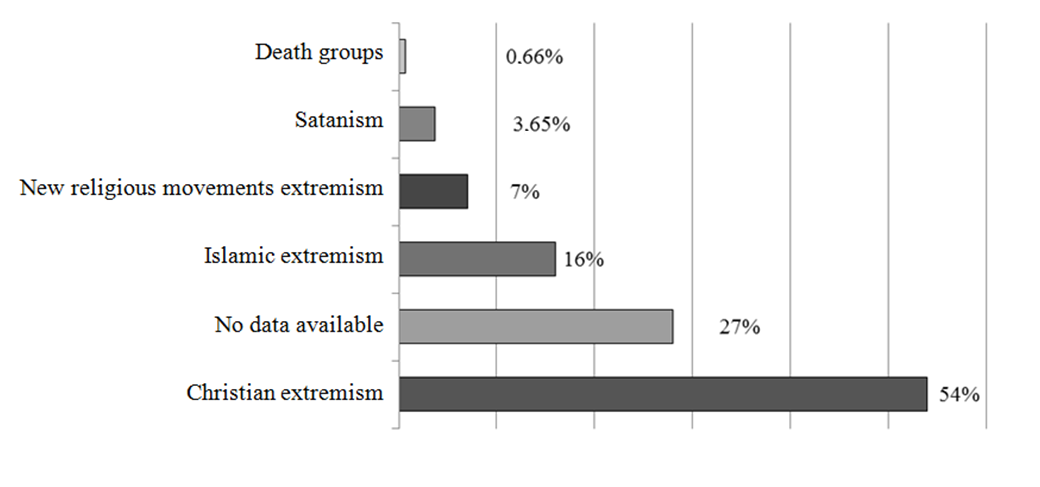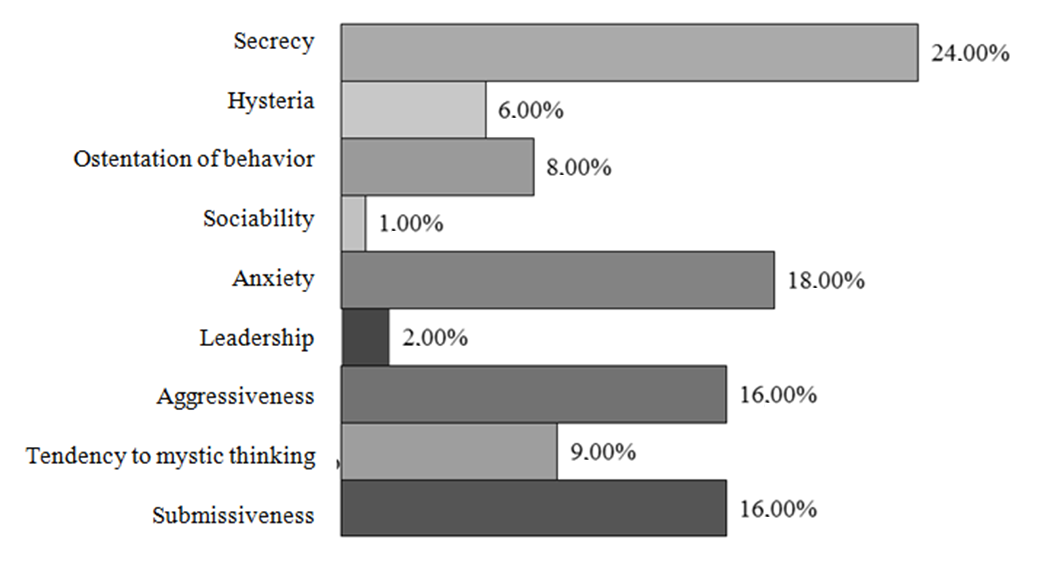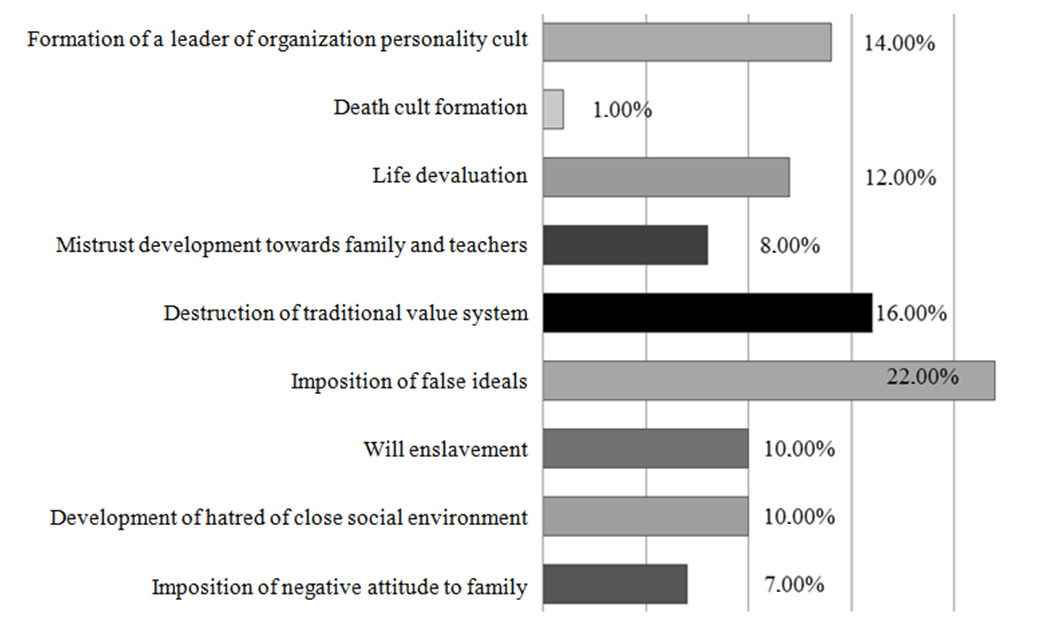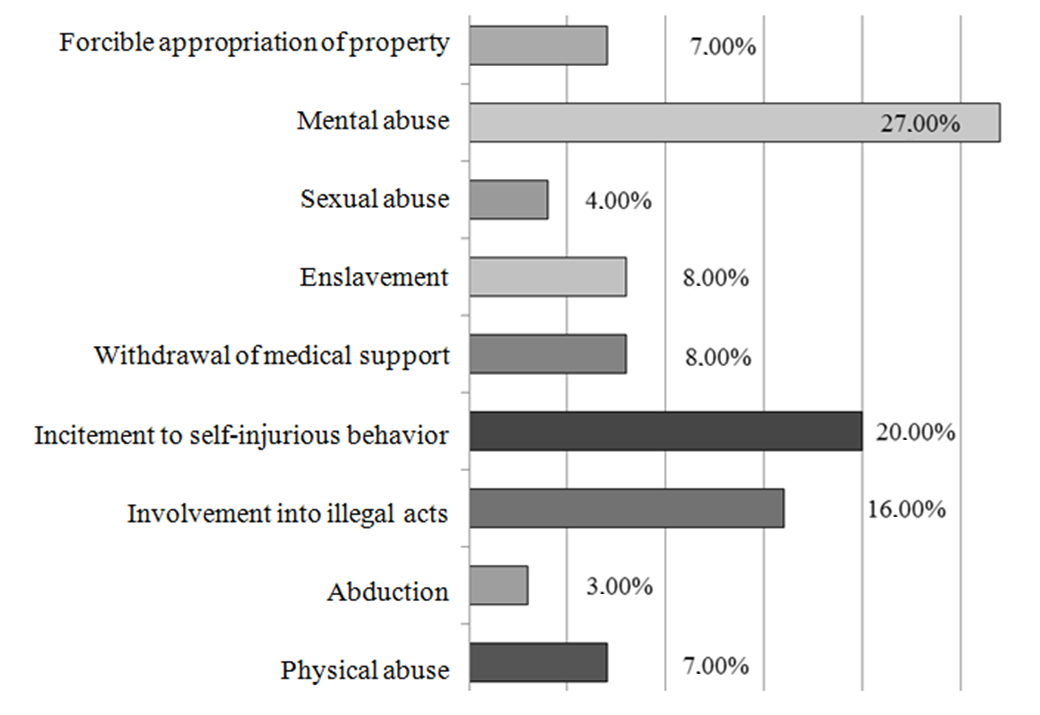Abstract
The article deals with the problem of destructive impact of extremist religious organizations on minors’ personality. Arrangement of special psychological and educational support can successfully solve the task of primary and secondary prevention of destructive impact of extremist organizations. This, in turn, requires an appropriate training of psychologists and teachers. The purpose of this study was to identify the conception of psychologists and teachers of general educational institutions concerning the threats posed by religious and extremist organizations to the minors. Moreover, if they are ready to implement primary and secondary prevention in this field. A questionnaire was developed to solve the research problems. The number of participants was 4106 people: management and educational staff, principal assistants on studies and educational work, psychologists, social teachers of educational institutions. The study showed that teachers and psychologists of educational organizations have general conception of the methods and psychological techniques of religious extremist and terrorist organizations’ impact on minors’ personality, as well as they know psychological characteristics of adolescents at risk. As a whole, most teachers and psychologists are aware of threats posed by religious extremist and terrorist organizations. However, about a quarter of respondents cannot assess these threats. This suggests the need to implement a comprehensive interagency training program for educators to implement primary and secondary prevention of the destructive impact of religious extremist and terrorist organizations on minors’ personality.
Keywords: Psychologistteacherdestructive impactextremist religious organizationspersonality
Introduction
Today, in the context of intellectual crisis and moral relativism, which affected all ethnic and cultural communities of Russia, religious extremism has become widespread, with the aim to undermine finally any ethical standards of the Russian state, based on highly spiritual principles of civic patriotism and rich experience of traditional religions of the country. Global and regional trends demonstrate a growing influence of extremist and terrorist groups, where radical religious movements play a leading role. Among them are such regional sects as the White Brotherhood and Jehovah's Witnesses, and large international terrorist networks that have any impressive economic, human and military resources (“Hizb ut-Tahrir”, “Muslim Brotherhood”, “Islamic State” and others) (Afanas’ev, 2001; Ushama, 2014; Zinchenko, 2008).
In recent years, the religious extremism has been associated with Islamism, exclusively, in the Russian minds. To this day, terrorist Islamists suicides terrorist attacks (including ethnic Russians) have become a real scourge to our country. However, recently Russia has faced a relatively new kind of religious extremism, which has grown on the fruitful field of liberalism (acts of vandalism in churches, desecration of Orthodox shrines, etc.).
Often, extremist and terrorist organizations supporters use adolescents for indoctrination and recruitment as the most vulnerable group for their further use as a demographic resource for their organizations. Thus, an additional growth factor stimulating deviant and delinquent behaviour appears in adolescents and young adults. Religious extremists tell young people what they want to hear, concerning the imperfection and depravity of the modern world and the need for its early and radical change. Extremists use the youth as their weapons fighting against traditionalism putting their ideology into their hearts and minds (Aksakalova, Nurgaliyeva, Aksakalova, & Abdrakhmanov, 2014; Mammaev, Mollaeva, Damadaeva & Magomedova 2016; Zinchenko, 2008).
Different ideologies affect young people more than other social groups, due to psychological instability and social immaturity. Inherent adolescence rigidity often contradicts the norms of mutual tolerance in the modern global space, which leads to negative consequences both for the individual and for society as a whole. The wide participation of adolescents and young people in activities of extremist religious and political organizations is the evidence thereof (Williams, Bernard, & Jeffers, 2017; Schils & Verhage, 2017).
Unpreparedness of young people for manipulative actions of fraudsters, ignorance of any elaborated models and lack of skills in identification of deceptions lead to ideological enslavement. Assimilation of negative behavioral attitudes poses a serious threat to young people and society as a whole. The involvement of young people in religious sects is fraught with serious consequences: loss of national culture, identity, mentality (Dontsov, Drozdova, & Gritskov, 2013; Kisliakov, Shmeliova, & Tolstov, 2015).
In addition to the actual ideological (religious) addiction, charismatic leaders of extremist sects actively use drugs and other forms of addiction in order to enslave an adept’s life. As a result, the task of psychological and educational work with minors in general education institutions becomes critical.
Problem Statement
Recognizing the significant role of education in socialization of younger generation, the state imposes new requirements on educational organizations to form an independent, conscious, responsible and socially mobile personality capable of active adaptation (Asmolov, 2013; Shmeleva, Kislyakov, Kartashev & Romanova, 2017). The arrangement of special psychological and educational support can successfully solve the task of primary and secondary prevention of extremist organizations destructive influence, which in turn requires an appropriate training of psychologists and teachers.
Research Questions
-
What is psychologists and teachers conception of modern religious extremist organizations?
-
Do teachers and psychologists know the ways and psychological methods of impact on the minors’ personality used by religious extremist and terrorist organizations?
-
Do psychologists and teachers know psychological characteristics of adolescents-at-risk?
Purpose of the Study
Purpose of this study was to identify the conception of psychologists and teachers of general educational institutions concerning the threats posed by religious and extremist organizations to the minors. Moreover, if they were ready to implement primary and secondary prevention in this field.
Research Methods
We developed a questionnaire to solve the research problems. We conducted the study remotely by placing the questionnaire in the Internet using Google Forms tool. Data collection took place from 1-7 December 2017. Representatives from 37 regions of the Russian Federation participated in the study. Among the educational organizations that took part in monitoring, the majority were general education institutions, such as schools, high schools, and secondary vocational education schools. The number of participants was 4106 people, i.e. management and educational staff, principal assistants on studies and educational work, psychologists, social teachers of educational institutions.
Findings
The analysis of the data received revealed that according to respondents the “Pseudo-Christian” extremism was a predominant form of extremism expression (Fig.

Pseudo-Islamic extremism, represented in Russian regions by several international organizations (“Muslim Brotherhood”, “Hizb-ut Tahrir” and others), and some local cells, and even single preachers, has gained 16% according to the survey results, reflecting a threat of spreading the ideas of Salafism and Wahhabism among young people. This problem is particularly acute in North Caucasus, the Volga region and Moscow.
Every fourth (27%) participant of the survey showed unawareness of or carelessness with the problem of religious extremism.
The monitoring results showed, that despite the tension in media the respondents thought that numerous small groups of “New religious movements”, Satanism, and “Death groups” were the least active and apparently only potentially dangerous (totalled 12%).
In addition, the study revealed a number of dominant features characterizing teenagers exposed to some destructive psychological impacts of religious, extremist and terrorist ideology supporters.
The dominant feature, according to respondents, was the teenager’s “Secrecy” (24%), his/her focus on internal experiences and lack of credibility, which found to be a fertile field for the development of “sectarian outlook” and tunnel thinking (Fig.

The second less pronounced psychological feature was “Anxiety” (18%), probably resulting from teenager’s personal injury. It is worth pointing out that the adolescents often fall into destructive cults, due to an adverse social status of their parental household. Unemployment, alcoholism and abuse create conditions for a prolonged sense of emotional discomfort, anxiety, and, accordingly, escapist aspirations, the desire for a radical solution of all problems, including those solvable through the appeal to religious worship objects.
The third feature, indicated by the respondents, was “Submissiveness” (16%), a tendency to relatively easy submission to authorities and charismatic leaders, so popular among neo-Protestant and other Christian fundamentalist confessions.
The less pronounced are such symptomatically related indicators as “Hysteria” (6%) and “Ostentation of behavior” (8%) are less pronounced though they are in fact the signs of the same repression mechanism aimed at eliminating the socially unacceptable individual drives. Probably, the inner conflict with his/her own drives and needs often leads adolescents to religion. It entails alternative, i.e. destructive religiosity coupled with general religious illiteracy and opposition to parental authority.
A share of such specific property as “Mystical thinking” is relatively small (9%) as compared to the others, which reflects the attitudes of extremist groups although radical, but rationally explained.
Despite the created in media image, the destructive sects and terrorist organizations are often indifferent to excessive mysticism and ritual practice, keeping them as a necessary component of their ideology, but paying much attention to rationally based ideas of social and political restructuring, as well as teaching their adepts some tactical methods of radical and terrorist struggle.
According to the survey, members of extremist movements have predictably suppressed such social and psychological qualities as “Sociability” (1%) and “Leadership” (1%), and this is fully consistent with the indicators of submissiveness and secrecy.
A wider range of variance characterizes the following indicator.
The respondents believe that the destructive impact of religious extremist and terrorist organizations on minors’ personality includes several components, among which the “Imposition of false ideals” (22%) and “Destruction of traditional value systems” (16%) have priority (Fig.

The respondents also indicated the classic methods of destructive sects and organizations i.e. a break with the inner social environment, family and friends for the sake of deeper and total integration of a teenager into their community (24% in total).
The percentage of “Devaluation of life” response (12%) seems interesting for the purpose of further research in contrast to negligible activity of death groups in the regions. The educators have rated it below 1% of the total activity of other groups, indicating a very low share of the real activity of the death groups in social networks compared to religious destructive cults, which once again entails critical attitude to the media.
“Will enslavement” (10%) is also a well-known way of indoctrination, recruitment and programming of consciousness. The suppression with a subsequent submission of the entire emotional and volitional sphere is achieved through the whole system of adept’s new life style, that is closed, with a minimum of free time and personal space, filled with performance of ritual actions, physical and mental exercises, ascetic restrictions and any assignments as directed by a leader of organization - from innocent distribution of brochures and leaflets of the religious and missionary contents to accomplishment of illegal acts for the benefit of a destructive cult.
The survey revealed that the most frequently used methods of destructive impact on minors behaviour were “Mental abuse” (27%) and “Incitement to self-injurious behaviour” (20%), in respondents’ opinion, which again referred us to the aforesaid “Death groups” (Fig.

Involvement into illegal acts (16%) illustrates the dangers that only some regions of Russia have faced so far. The use of adolescents as consumed mobilization resource for the purpose of illegal acts is due to the sensibility of minors to manipulative practices, the desire to violate social norms and parental prohibitions.
Conclusion
Thus, this study showed that teachers and psychologists of educational organizations had a general conception of the methods and psychological techniques of the impact of religious extremist and terrorist organizations impact on minors’ personality, as well as they know psychological characteristics of adolescents at risk. As a whole, most teachers and psychologists are aware of the threats posed by religious extremist and terrorist organizations. However, about a quarter of respondents cannot assess these threats. This suggests the need to implement a comprehensive interagency training program for educators to implement primary and secondary prevention of the destructive impact of religious extremist and terrorist organizations on minors’ personality. The purpose of this program should be the acquisition of knowledge by teachers and psychologists in the field of regulatory and legal framework, interaction of an educational organization with representatives of the Executive authorities and employees of education, health, culture, and social protection system organizations, as well as public associations, representatives of traditional faiths. The program should prepare teachers and psychologists for identifying children and adolescents subjected to a destructive psychological impact by religious extremist and terrorist ideology supporters; determining the degree of disturbance in mental, personal and social development of adolescents; developing skills of support and educative work with children and their parents.
Acknowledgments
The publication was prepared within the framework of a research project supported by the Russian Foundation for Basic Research (grant No. 18-413-370002\18 “Socio-Cultural Needs of Young People in Countering Emerging Threats and Risks”.
References
- Afanasiev, N. N. (2001). The ideology of terrorism. Sotsialno-gumanitarniye znaniya, 6, 205-219.
- Aksakalova, Z. K., Nurgaliyeva, U. S., Aksakalova, M. K., Abdrakhmanov, A. E. (2014). Research of value-and-sense system of youth as a basis for psychological resilience of a person to destructive religious movements. Life Science Journal, (SPEC. ISSUE 5), 13, 72-74.
- Asmolov, A. G. (2013). Strategy and methodology for the sociocultural reform of education. Psychology in Russia: State of the Art, 6, 3-20.
- Dontsov, A. I., Drozdova, A. V., Gritskov, Y. V. (2013). Visual culture and personal psychological security. Procedia — Social and Behavioral Sciences, 86, 70-75. DOI: 10.1016/j.sbspro.2013.08.527.
- Kisliakov, P. A., Shmeliova, E. A., Tolstov, S. N. (2015). Social psychological safety of subjects of education. Voprosy psikhologii, 5, 46-52.
- Mammaev, S. N., Mollaeva, N. R., Damadaeva, A. S., Magomedova, S. A. (2016). Psychophysiological reasons for extremist behavior. Research Journal of Pharmaceutical, Biological and Chemical Sciences, 7(6), 213-220.
- Schils, N., Verhage, A. (2017). Understanding how and why young people enter radical or violent extremist groups. International Journal of Conflict and Violence, 11, 17.
- Shmeleva, E. A., Kislyakov, P. A., Kartashev, V. P. Romanova, A. V. (2017). Innovative activities and socio-psychological security in professional and personal development. RRI 2016 - International Conference Responsible Research and Innovation. European Proceedings of Social and Behavioural Sciences, 26, 921-926. DOI: 10.15405/epsbs.2017.07.02.119.
- Sosnin, V. A. (2016). Psychological and worldview counteraction to terrorism in contemporary world. Psikhologicheskii Zhurnal, 37(2), 136-144.
- Ushama, T. (2014). The phenomenon of extremism in religion in Muslim life: An analysis of its roots, causes and nature. Asian Social Science, 10(14), 239-253.
- Volkov, E. N. (1996). Methods of recruitment and control of consciousness in destructive cults. Zhurnal prakticheskogo psixologa, 3, 56-81.
- Volkov, E. N. (1997). Consulting the victims of intensive psyche manipulations: main principles, features of practice. Zhurnal prakticheskogo psixologa, 1, 21-35.
- Williams, G.-R., Bernard, M. L., Jeffers, R. F. (2017). Examining the, ideological, sociopolitical, and contextual factors underlying the appeal of extremism. Advances in Intelligent Systems and Computing, 480, 307-319.
- Zinchenko, Yu. P. (2008). Psychology of Safety and Resistance to Terrorism. Psychology in Russia: State of the Art, 1, 81-101.
Copyright information

This work is licensed under a Creative Commons Attribution-NonCommercial-NoDerivatives 4.0 International License.
About this article
Publication Date
17 December 2018
Article Doi
eBook ISBN
978-1-80296-049-5
Publisher
Future Academy
Volume
50
Print ISBN (optional)
-
Edition Number
1st Edition
Pages
1-1464
Subjects
Social sciences, modern society,innovation, social science and technology, organizational behaviour, organizational theory
Cite this article as:
Kislyakov, P., Sergeev, S., Strelkov, V., Belyakova, N., & Romanova, A. (2018). Psychologists And Teachers Conception Of Destructive Impact Of Extremist Organizations On Minors. In I. B. Ardashkin, B. Vladimir Iosifovich, & N. V. Martyushev (Eds.), Research Paradigms Transformation in Social Sciences, vol 50. European Proceedings of Social and Behavioural Sciences (pp. 584-591). Future Academy. https://doi.org/10.15405/epsbs.2018.12.71

